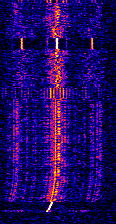PSK Paging link
From Signal Identification Wiki
| Paging Modes | |
|---|---|
| AFSK Paging Link - POCSAG - Glenayre Paging Link - FLEX - ReFLEX - Golay Paging (GSC) - European Radio Message System (ERMES) - Multitone Paging |
This signal has been found at: 454.475 MHzMegaHertz (MHz) 10^6 Hz In Chicago, IL. The input signal rests on 158.1 MHzMegaHertz (MHz) 10^6 Hz. The cause of the DSP is unknown, but the transmitter rests on top of Chicago's Oglive Transport center. However, it acts as a normal paging license. The license is unknown because of the input of 158.1 MHzMegaHertz (MHz) 10^6 Hz. FCC databases unfortunately do not list a license under these two frequencies. However, it could be possible that KSA810 is the license, but the license does not include 158.1 on the list of frequencies.
